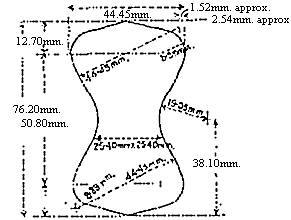S.I. No. 144/1938 - Portland Cement (Standard of Quality) Order, 1938.
STATUTORY RULES AND ORDERS. 1938. No. 144. | ||||||||||||||||||||||||||||||||||
PORTLAND CEMENT (STANDARD OF QUALITY) ORDER, 1938. | ||||||||||||||||||||||||||||||||||
WHEREAS it is enacted by sub-section (1) of section 9 of the Cement Act, 1933 (No. 17 of 1933), that the Minister for Industry and Commerce shall, as soon as may be after the commencement of the said Act, by order under the said sub-section appoint by reference to quality the standard to which Portland cement manufactured by holders of cement manufacture licences is to conform : | ||||||||||||||||||||||||||||||||||
NOW, THEREFORE, the Minister for Industry and Commerce, in pursuance of sub-section (1) of section 9 of the Cement Act, 1933 (No. 17 of 1933), and in exercise of the powers conferred on him by the said sub-section and of every and any other power him in this behalf enabling, hereby orders as follows :— 1. This Order may be cited as the Portland Cement (Standard of Quality) Order, 1938. 2. The Interpretation Act, 1937 (No. 38 of 1937), applies to this Order. 3. The standard to which Portland cement manufactured by holders of cement manufacture licences is to conform shall be the standard set out in the Schedule hereto. | ||||||||||||||||||||||||||||||||||
|
SCHEDULE. | ||||||||||||||||||||||||||||||||||
STANDARD SPECIFICATION FOR PORTLAND CEMENT. | ||||||||||||||||||||||||||||||||||
CHEMICAL AND PHYSICAL TESTS. | ||||||||||||||||||||||||||||||||||
Portland cement shall comply with the following Chemical and Physical requirements. | ||||||||||||||||||||||||||||||||||
(1) Chemical Composition. | ||||||||||||||||||||||||||||||||||
It should contain no additions subsequent to calcination other than water or calcium sulphate or both. | ||||||||||||||||||||||||||||||||||
The following limits shall not be exceeded :— | ||||||||||||||||||||||||||||||||||
| ||||||||||||||||||||||||||||||||||
1·9 nor greater than 2·8. In this expression the percentages are by weight as obtained in the analysis. | ||||||||||||||||||||||||||||||||||
PHYSICAL TESTS. | ||||||||||||||||||||||||||||||||||
(2) Fineness. | ||||||||||||||||||||||||||||||||||
(a) The residue, by weight, on a standard wire woven sieve with 67 meshes nominal to the lineal centimetre shall not exceed 10 per cent. | ||||||||||||||||||||||||||||||||||
(b) The residue, by weight, on a standard wire woven sieve with 28 meshes nominal to the lineal centimetre shall not exceed 1 per cent. | ||||||||||||||||||||||||||||||||||
The fineness shall be ascertained by means of and in conformity with the Tests for Fineness set out in the Appendix to this Schedule. | ||||||||||||||||||||||||||||||||||
(3) Setting Time. | ||||||||||||||||||||||||||||||||||
(a) Normal-setting cement. | ||||||||||||||||||||||||||||||||||
The initial setting time of normal-setting cement determined by the Vicat apparatus shall not be less than 30 minutes and the final setting time not more than 10 hours. | ||||||||||||||||||||||||||||||||||
(b) Quick-setting cement. | ||||||||||||||||||||||||||||||||||
The initial setting time of a quick-setting cement determined by the Vicat apparatus shall not be less than 5 minutes and the final setting time not more than 30 minutes. | ||||||||||||||||||||||||||||||||||
The setting time shall be ascertained by means of and in conformity with the Tests for Setting Time set out in the Appendix to this Schedule. | ||||||||||||||||||||||||||||||||||
(4) Soundness. | ||||||||||||||||||||||||||||||||||
The expansion shall be determined by the " Le Chatelier " method and shall not exceed 5 mm. If this is exceeded a further test shall be made after seven days' aeration, when, if the expansion does not exceed 2·5 mm., the sample shall be considered to have passed the Soundness test. The Soundness shall be ascertained by means of and in conformity with the Tests for Soundness set out in the Appendix to this Schedule. | ||||||||||||||||||||||||||||||||||
(5) Tensile Strength.—Cement Mortar. | ||||||||||||||||||||||||||||||||||
Normal Cement. | ||||||||||||||||||||||||||||||||||
The average breaking strength of four cement mortar briquettes, composed of one part by weight of cement to three parts by weight of standard sand, shall not be less than :— | ||||||||||||||||||||||||||||||||||
At 3 days after gauging 23 kg. per square centimetre (327 lbs. per square inch). | ||||||||||||||||||||||||||||||||||
At 7 days after gauging 30 kg. per square centimetre (427 lbs. per square inch). | ||||||||||||||||||||||||||||||||||
In all cases the average strength at seven days shall be greater than the average strength at three days. The standard sand shall be a natural quartz sand thoroughly washed and dried. It shall pass through a standard wire woven sieve with 7 meshes nominal to the lineal centimetre and shall be retained on a standard wire woven sieve with 10 meshes nominal to the lineal centimetre. | ||||||||||||||||||||||||||||||||||
RAPID HARDENING CEMENT. | ||||||||||||||||||||||||||||||||||
Where a rapid hardening cement is specified the average tensile strength of four standard mortar briquettes shall be not less than :— | ||||||||||||||||||||||||||||||||||
At 3 days after gauging 32 kg. per square centimetre (455 lbs. per square inch). | ||||||||||||||||||||||||||||||||||
At 7 days after gauging 37 kg. per square centimetre (526 lbs. per square inch). | ||||||||||||||||||||||||||||||||||
In all cases the average strength at seven days shall be greater than the average strength at three days. | ||||||||||||||||||||||||||||||||||
The tensile strength shall be ascertained by means of and in conformity with the Test for Tensile Strength set out in the Appendix to this Schedule. | ||||||||||||||||||||||||||||||||||
APPENDIX. | ||||||||||||||||||||||||||||||||||
METHODS OF TESTING. | ||||||||||||||||||||||||||||||||||
TESTS FOR FINENESS. | ||||||||||||||||||||||||||||||||||
(1) The sieves shall be wire woven with apertures of ·211 mm. and ·089 mm. (side of square) in the sieves with nominally 28 meshes and 67 meshes respectively per lineal centimetre. The area of the sieves shall not be less than 300 square centimetres and the depth of the frame not less than 7 centimetres above the wire cloth. 100 grammes of cement shall be placed in the 67 mesh sieve and continuously sifted, being moved horizontally and vertically with gentle taps for a period of 15 minutes, air set lumps being broken down with the fingers. After weighing, the residue shall be placed in the 28 mesh sieve and continuously sifted as before for a period of 5 minutes. | ||||||||||||||||||||||||||||||||||
TESTS FOR SETTING TIME. | ||||||||||||||||||||||||||||||||||
(2) The Vicat apparatus shall be used to determine the setting times of the cement. The needle for the initial setting test shall be 1 mm. square in section and have a flat end and shall be loaded so that the needle and load together weigh 300 grammes. The needle for the determination of the final setting time shall be of the same cross-section but with a metal attachment 5 mm. in diameter hollowed out to form a sharp circular edge and with the needle projecting 0·5 mm. below it. The mould shall be 80 mm. diameter and 40 mm. deep. | ||||||||||||||||||||||||||||||||||
500 grammes of cement shall be gauged with the necessary quantity of water to form a cement paste of normal consistency and the mould filled in the manner and under the conditions described in Appendix Clause 5. | ||||||||||||||||||||||||||||||||||
Initial Setting Time. | ||||||||||||||||||||||||||||||||||
For the determination of initial setting time the mould shall then be placed resting on its plate under the 1 mm. square needle. The needle shall then be lowered gently until it is in contact with the surface of the test block and suddenly released and allowed to sink into it ; the operation being repeated until the needle just fails to reach the base of the test block. The time from the moment of adding the water to the cement until the needle just fails to completely pierce the test block shall be the initial setting time. | ||||||||||||||||||||||||||||||||||
Final Setting Time. | ||||||||||||||||||||||||||||||||||
For the determination of final setting time, the 1 mm. square needle is removed from the rod of the Vicat apparatus and replaced by the 1 mm. square needle with the 5 mm. diameter metal attachment, which is gently lowered to the surface of the test block. The cement shall be considered to have finally set when the needle makes an impression on the surface of the test block but the circular attachment fails to mark it. | ||||||||||||||||||||||||||||||||||
The mould may be reversed and the underneath side of the test block used for this test if a scum has formed on the upper surface. | ||||||||||||||||||||||||||||||||||
TEST FOR SOUNDNESS. | ||||||||||||||||||||||||||||||||||
(3) The test for soundness shall be made by the " Le Chatelier " method. The standard apparatus consists of a split cylinder forming a mould 30 mm. internal diameter and 30 mm. deep. Two indicators with pointed ends are symetrically attached to the mould, one on each side of the split. The distance from the centre of the mould to the line joining the points of the indicators is 165 mm. | ||||||||||||||||||||||||||||||||||
The cement shall be gauged to form a paste of normal consistency as described in Appendix Clause 5. The mould shall be placed on a glass plate and filled with the paste, the edges of the mould being kept gently together during the operation. The mould is then covered with another glass plate and a small lead weight placed on top, and the whole immersed in water at a temperature of 14·4 to 17·8 degrees Centigrade (58 to 64 degrees Fahrenheit) for 24 hours. | ||||||||||||||||||||||||||||||||||
The distance between the indicator points shall then be measured and the mould again immersed in water, within the temperatures mentioned above. The water shall then be brought to boiling point in from 25 to 30 minutes and kept boiling for 3 hours. The mould shall then be removed from the water and allowed to cool and the distance between the indicator points again measured. The difference between the two measurements gives the expansion of the cement. Should the expansion exceed 5 mm. a further test shall be made from the same sample after it shall have been aerated for 7 days, by being spread out to a depth of 70 mm. in a room at standard temperature. The expansion determined as described above shall not now exceed 2·5 mm. | ||||||||||||||||||||||||||||||||||
TEST FOR TENSILE STRENGTH. CEMENT MORTAR. | ||||||||||||||||||||||||||||||||||
(4) The briquettes shall be of the shape and dimensions shown in Fig. 2 and shall be prepared in the following manner :— | ||||||||||||||||||||||||||||||||||
Cement and sand in the proportion of one part by weight of cement to three parts by weight of the standard sand shall be gauged with clean fresh water, the percentage of water to be used being determined from the diagram Fig. 1. The mortar gauged as above shall be filled into the moulds whose internal dimensions are of the sizes and shape necessary to form briquettes of the dimensions shown in Fig. 2. Each mould shall be placed on a non-absorbent or metal plate. After filling the mould more mortar is placed on the top and beaten down with a standard spatula until the mortar is level with the top of the mould. The mould shall then be turned over and the operation repeated on the other side, the mortar being beaten down until water appears on the surface. The flat only of the spatula shall be used, and no other method or apparatus shall be used for ramming the mortar in this operation. | ||||||||||||||||||||||||||||||||||
The standard spatula shall be of steel with a wooden handle attached, and shall have a total length of approximately 355 mm. The flat shall be about 73 mm. long, 46 mm. wide, 5·6 mm. thick at the centre, tapering to the edges. Its weight shall not exceed 350 grammes and its centre of gravity shall be practically in the centre of the length of the spatula. | ||||||||||||||||||||||||||||||||||
The briquettes shall be kept in a damp box or chamber with a relative humidity of 90 per cent. for 24 hours after gauging, when they shall be taken out of the moulds and immediately immersed in clean water and kept there until required for testing. After the briquettes are taken out of the water and until they are tested, they must be kept wet. | ||||||||||||||||||||||||||||||||||
The briquettes shall be tested for breaking strength at 3 days and 7 days respectively from the time of filling the moulds. The breaking strength shall be the average tensile breaking strength of the four briquettes for each period. The briquettes shall be held centrally in metal jaws of the shape shown in Fig. 3 and thin oiled paper shall be placed between the surfaces of the briquette and the jaws. The load shall be uniformly applied commencing at zero and increasing at the rate of 6 kg. in 10 seconds. | ||||||||||||||||||||||||||||||||||
The sieves used in the determination of the size of the standard sand shall be wire woven, with apertures of ·853 mm. and ·599 mm. (side of square) in the sieves with nominally 7 meshes and 10 meshes respectively per lineal centimetre. | ||||||||||||||||||||||||||||||||||
TEMPERATURES. | ||||||||||||||||||||||||||||||||||
In the tests for Setting Time, Soundness and Tensile Strength the operations indicated therein shall be conducted in a laboratory maintained at a temperature between 14·4 and 17·8 degrees Centigrade (58 and 64 degrees Fahrenheit). The same temperature limits shall apply to all water used in connection with the tests. | ||||||||||||||||||||||||||||||||||
DETERMINATION OF NORMAL CONSISTENCY OF CEMENT PASTE. | ||||||||||||||||||||||||||||||||||
(5) For the purpose of the above tests for Setting Time, Soundness and Tensile Strength, the percentage of water required for gauging a Cement Paste of normal consistency, and the percentage of water for gauging three to one standard sand and cement mortar, shall be determined in the following manner, that is to say :— | ||||||||||||||||||||||||||||||||||
The Vicat apparatus, as universally adopted, shall be used with a 10 mm. diameter brass plunger, 50 mm. long, with flat lower end, and loaded so that the plunger and load together weigh 300 grammes. The mould to be used shall be 80 mm. diameter and 40 mm. deep. | ||||||||||||||||||||||||||||||||||
500 grammes of cement shall be gauged with a measured quantity of clean fresh water, and the time from the moment of adding the water to commencing to fill the mould shall not be less than three minutes nor more than five minutes. The mould resting upon a non-absorbent plate shall be completely filled, the operator's fingers and an ordinary gauging trowel (weighing about 200 grammes) only being used. The surface of the paste shall be smoothed off level with the top of the mould. The temperature of the room and of the cement and water at the time the operations are being performed shall be from 14·4 to 17·8 degrees Centigrade (58 to 64 degrees Fahrenheit). The mould, immediately it is filled, shall be placed, resting on its plate under the 10 mm. diameter brass plunger, the plunger shall be lowered gently until in contact with the surface of the trial block and then suddenly released and allowed to sink into it. The quantity of water used in gauging is to be regulated until the paste is such that the plunger comes to rest 6 mm. (with a tolerance of ± 1 mm.) above the bottom of the trial block. The amount of water used to obtain this result shall be expressed as a percentage by weight of the dry cement. | ||||||||||||||||||||||||||||||||||
From the percentage so determined the diagram Fig. 1 shows the percentage of water required for gauging a cement paste of normal consistency. The diagram also indicates the percentage of water for gauging 3 to 1 Standard Sand and Cement Mortar. | ||||||||||||||||||||||||||||||||||
FIG. 1. | ||||||||||||||||||||||||||||||||||
DIAGRAM SHOWING PERCENTAGES OF WATER FOR PASTE OF NORMAL CONSISTENCY AND STANDARD MORTAR. | ||||||||||||||||||||||||||||||||||
| ||||||||||||||||||||||||||||||||||
Example :— | ||||||||||||||||||||||||||||||||||
| ||||||||||||||||||||||||||||||||||
FIG. 2. | ||||||||||||||||||||||||||||||||||
| ||||||||||||||||||||||||||||||||||
Briquette to have a uniform thickness of 25·4 mm. throughout. | ||||||||||||||||||||||||||||||||||
FIG 2. DIMENSIONS OF STANDARD BRIQUETTE. | ||||||||||||||||||||||||||||||||||
| ||||||||||||||||||||||||||||||||||
| ||||||||||||||||||||||||||||||||||
FIG. 3. ELEVATION AND PLAN OF JAWS FOR HOLDING BRIQUETTE. | ||||||||||||||||||||||||||||||||||
Given under the Seal of Office of the Minister for | ||||||||||||||||||||||||||||||||||
Industry and Commerce. this 14th day of | ||||||||||||||||||||||||||||||||||
April, 1938. | ||||||||||||||||||||||||||||||||||
JOHN LEYDON, Secretary, | ||||||||||||||||||||||||||||||||||
Department of Industry and Commerce. | ||||||||||||||||||||||||||||||||||




